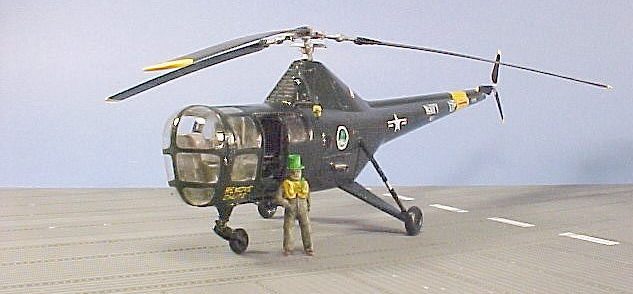
Fonderie Miniature 1/48 HO3S-1
|
KIT # |
? |
|
PRICE: |
$29.95 |
|
DECALS: |
3 Aircraft, USN, USMC, Aeronavale |
|
REVIEWER: |
|
|
NOTES: |
Short run multimedia kit |

|
HISTORY |
The Sikorsky HO3S-1 was the first helicopter to be capable of carrying a really useful load at a useful speed. It became the first helicopter used by several different air forces, and was a workhorse of the Korean War, where it pioneered the plane guard role for the rescue at sea of downed naval aviators, as well as the rescue of allied flyers from behind enemy lines. The helicopter was immortalized in the film "The Bridges at Toko-ri."
Following the success of the Sikorsky R-4, the first helicopter used by U.S. armed forces, Sikorsky planned two developments: a two-seater later known as the R-6/HOS-1, and a larger observation helicopter for the USAAF that was first ordered in 1943 as the XR-5; this was followed by 36 YR-5As and 34 R-5As, which can be distinguished from the later S-51 (known as the R-5F and HO3S-1 in military service) by a narrow front fuselage with outrigger main wheels and a trailing tailwheel.
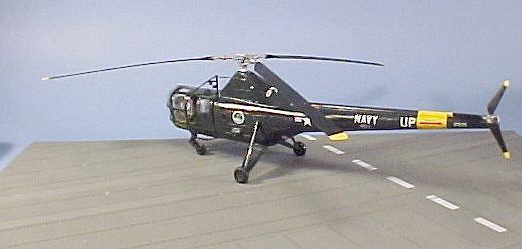 The S-51, a four seat
(1 + 3) helicopter developed for the commercial market, first flew February 16,
1946. Powered by a Pratt & Whitney R-985 radial of 450 horsepower, the S-51 had
a payload of 1,000 lbs, a considerable improvement on all previous helicopters
built by anyone. The USAAF and USN immediately became interested in this
helicopter; 66 R-5F, G, and H versions were ordered for the Air Force, while the
Navy ordered 95 HO3S-1s which were delivered between 1946-50. Nine of these
Navy helicopters became the first rotary-wing aircraft operated by the U.S.
Marines, while another 9 were transferred to the U.S. Coast Guard - who already
used the earlier R-4 in the SAR role - as the HO3S-1G. The primary use of the
HO3S-1 was in the plane guard role aboard "Essex" Class carriers, while the
Marine helos were later used in the medevac role in Korea.
The S-51, a four seat
(1 + 3) helicopter developed for the commercial market, first flew February 16,
1946. Powered by a Pratt & Whitney R-985 radial of 450 horsepower, the S-51 had
a payload of 1,000 lbs, a considerable improvement on all previous helicopters
built by anyone. The USAAF and USN immediately became interested in this
helicopter; 66 R-5F, G, and H versions were ordered for the Air Force, while the
Navy ordered 95 HO3S-1s which were delivered between 1946-50. Nine of these
Navy helicopters became the first rotary-wing aircraft operated by the U.S.
Marines, while another 9 were transferred to the U.S. Coast Guard - who already
used the earlier R-4 in the SAR role - as the HO3S-1G. The primary use of the
HO3S-1 was in the plane guard role aboard "Essex" Class carriers, while the
Marine helos were later used in the medevac role in Korea.
The RCAF chose the S-51 as its first operational helicopter and ordered 7 for SAR use in 1947. Westland Aircraft arranged for license production of the S-51 as the "Dragonfly" in the same year; powered by the Alvis Leonides 50 radial of 520 horsepower, 166 would eventually be built, the majority of which would be used by the Royal Navy as the Dragonfly HR Mk.1, with some used by the RAF for medevac as the HC Mk.2. British European Airways established the first passenger helicopter service with the Dragonfly in 1950.
The S-51 was the helicopter that established the type as the best aircraft for use in search and rescue, and also introduced the helicopter to the public as a reliable means of transportation. The current reputation of Sikorsky in the field of rotary-wing aviation stands on the achievements of the S-51 in all its variants.
"The Bridges at Toko-ri"
To my mind, as both
an aviation historian and enthusiast, and as a screenwriter, "The Bridges At
Toko-ri" stands out as the best flying movie ever made and one of the very best
war movies ever made. It is based on the very excellent novel by James
Michener, who wrote it after spending several months at sea with Task Force 77
in the Fall of 1952, during an air campaign that came to be known as "The
Cherokee Strikes." Several years ago, I had the opportunity in my role as
aviation 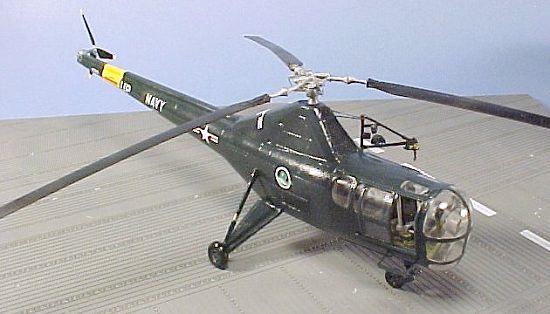 historian to interview Thomas J. Hudner, Jr., the only Naval Aviator to
win the Medal of Honor in the Korean War. When I asked what it was like flying
off the carriers then, he replied, "Did you ever see 'The Bridges At Toko-Ri'?
It was exactly like that." When I first saw it as a child, the movie was
shocking to me because it was the first movie I ever saw in which the heroes
died in the end. Later, after I had had my own experience of combat, I came to
appreciate that it was one of the few war movies that accurately portrays the
true nature of heroism in combat: the "hero" is a man who doesn't want to be
there and is afraid of the job he has been called on to do, yet does it anyway
in the most difficult circumstance.
historian to interview Thomas J. Hudner, Jr., the only Naval Aviator to
win the Medal of Honor in the Korean War. When I asked what it was like flying
off the carriers then, he replied, "Did you ever see 'The Bridges At Toko-Ri'?
It was exactly like that." When I first saw it as a child, the movie was
shocking to me because it was the first movie I ever saw in which the heroes
died in the end. Later, after I had had my own experience of combat, I came to
appreciate that it was one of the few war movies that accurately portrays the
true nature of heroism in combat: the "hero" is a man who doesn't want to be
there and is afraid of the job he has been called on to do, yet does it anyway
in the most difficult circumstance.
The character who steals every scene he is in is Chief Naval Aviation Pilot Mike Forney, played by Mickey Rooney, who flies the "angel" - the HO3S-1 assigned to the carrier for pilot rescue. I once interviewed Rooney, and mentioned my admiration of his work in this role. He replied that at the time he was advised to stay away from the project since it was deemed "controversial," and in McCarthy-Era Blacklist Hollywood, that was not a word one wanted in their resume, and it would end his career. "At the time, I didn't have a career!" he told me. His work in this movie in fact was what restored a career everyone in the industry had considered dead.
The aerial work for the movie was filmed aboard the USS "Oriskany." The field where the final action takes place still exists outside Simi Valley, about 35 miles from where I sit writing this.
To me as a kid, the two real "stars" of the movie were the HO3S-1 helicopter and the Grumman F9F-5 "Panther." Thus, I have been looking for years to add an HO3S-1 as the only helicopter in my model collection, and I had long ago decided it would be in the markings of the helicopter used in this movie.
|
THE KIT |
To say I am not a fan of Fonderie Miniature kits is an understatement. I have not found one yet that was not a practically-worthless PoS, and this kit was no different from the others. Had I not had a Belcher Bits resin kit of the HO3S-1 to use for most of the parts and the decals, the model would never have come into existence.
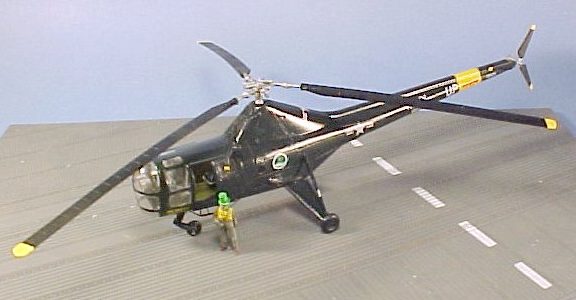 Why Fonderies
Miniatures chose to mold the fuselage in clear plastic is beyond me. As any
modeler knows, clear plastic is more brittle than opaque plastic. Even
companies who know what they are doing when it comes to casting plastic
sometimes have difficulties using this material. For a company like Fonderies
Miniatures, which seems to have trouble using normal plastic, the problems that
result from this choice are about ten times worse than from another
manufacturer. In addition to being brittle, the parts are thick; whatever
advantage for the windows in the cabin that was supposed to result from this
production choice is completely negated by the thickness of the parts, which
have the transparency of coke bottle glass at best. When I attempted to polish
out these parts, the slightest pressure exerted resulted in stress fractures
throughout the part; the nose cap shattered while attempting this, which came
very close to aborting the whole project within 30 minutes of commencement.
Why Fonderies
Miniatures chose to mold the fuselage in clear plastic is beyond me. As any
modeler knows, clear plastic is more brittle than opaque plastic. Even
companies who know what they are doing when it comes to casting plastic
sometimes have difficulties using this material. For a company like Fonderies
Miniatures, which seems to have trouble using normal plastic, the problems that
result from this choice are about ten times worse than from another
manufacturer. In addition to being brittle, the parts are thick; whatever
advantage for the windows in the cabin that was supposed to result from this
production choice is completely negated by the thickness of the parts, which
have the transparency of coke bottle glass at best. When I attempted to polish
out these parts, the slightest pressure exerted resulted in stress fractures
throughout the part; the nose cap shattered while attempting this, which came
very close to aborting the whole project within 30 minutes of commencement.
Additionally, the rotor blades supplied in the kit are too small, both in length and in chord; this is also true of the tail rotor. Fortunately, the resin rotor blades for main and tail rotor provided in the Belcher Bits kit are the correct size; they are also light enough in weight that they can be made to sit right. The Belcher Bits kit also provides the earlier, larger, wooden main rotor blades used on early-production S-51s.
The one good part of the kit is the main rotor hub, which is made in white metal. The other white metal parts were pretty much unusable. Fortunately, the Belcher Bits resin parts for the rotor head assembly were clean and crisp.
The kit decals provide two US HO3S-1s, one Navy and one Marine, and an HO3S-1 operated by the Aeronavale in the 1950s. Unfortunately, the font used in the lettering for the US markings is incorrect, and the national insignia is too small. Luckily, the decals for the Belcher Bits kit are excellent, providing markings for two US Navy HO3S-1s (including the "non-standard" markings used for the helicopter in the movie), a Marine HO-3S-1, two Royal Navy Dragonflies, a US Coast Guard HO3S-1G, and an RCAF S-51.
Overall, the main use of the Fonderies Miniature kit over the Belcher Bits kit was that the F-M fuselage was lighter than the resin fuselage of the B-B kit, with better surface detail. Also, the F-M kit has a good photo-etch fret, which provides the covers for the engine intake and exhausts, and detail parts for the hoist.
|
CONSTRUCTION |
As stated above, the
project nearly came to a screeching halt when the nose cap of the Fonderies
Miniatures kit shattered while being polished. Fortunately, the Belcher Bits
kit provides the canopy windscreen and cockpit walls with windows in vacuform.
They are slightly smaller than the F-M parts, but by cutting off those sections
of the forward fuselage on the F-M kit, and then sanding the centerline join so
it was narrower at the forward end, I was able to adapt the vacuform parts to
the F-M fuselage.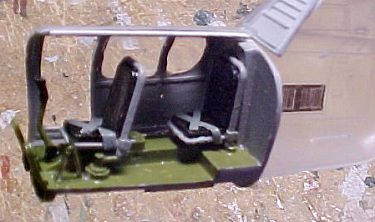
The F-M parts for the seats and controls were good and were used. I adapted the F-M photo-etch instrument panel to the Belcher Bits instrument pylon, which generally looked better and had more detail. I added some structural detail to the vacuform parts with Evergreen strip, then carefully attached the vacuform parts to the F-M fuselage. There was quite a bit of test-fitting necessary to trim down the centerline joint of the cockpit panels, so they would mate with the windscreen. I filled the joint line on the outside with C-A glue, and made a flat panel to fit inside the cockpit roof to strengthen that joint. I also put some fish weights under the cockpit floor to insure nose-sitting when the model was finished.
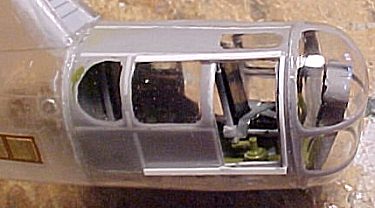 At this point, I
realized that the "centerline" of the parts for the Fonderies Miniatures
fuselage was not actually the real centerline, so I spent some considerable
amount of time with a sanding stick, getting the parts so that there was
symmetry to each part to each side when joined. Needless to say, holding the
parts hard enough to keep them in place while sanding resulted in more stress
fractures throughout the two parts. These were backed with more C-A glue from
the inside.
At this point, I
realized that the "centerline" of the parts for the Fonderies Miniatures
fuselage was not actually the real centerline, so I spent some considerable
amount of time with a sanding stick, getting the parts so that there was
symmetry to each part to each side when joined. Needless to say, holding the
parts hard enough to keep them in place while sanding resulted in more stress
fractures throughout the two parts. These were backed with more C-A glue from
the inside.
With the fuselage halves joined, I then sanded down the exterior of the fuselage so that I got rid of the stress cracks. This also resulted in the pebbly surface being smoothed up. I applied a considerable bit of Mr. Surfacer to the centerline joint, the seams around the cockpit, and over all the stress cracks, and set it aside.
I then separated the
rotor blades from their backing. Given the serial number of the HO3S-1 I
planned to make, it seemed it was a late-production variant, so I used the metal
main rotor blades. I also assembled the main rotor hub, using a
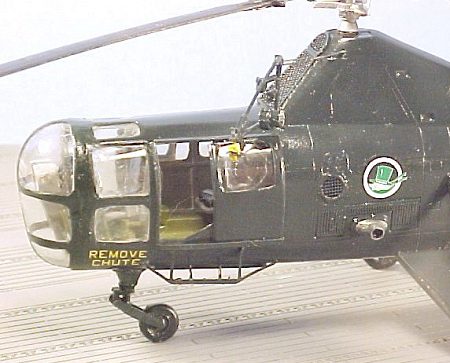 fairly good
drawing of the hub that was in the F-M instructions. Other than that, those
instructions were virtually useless, since there are no part numbers, and the
drawings of the various parts are not an accurate representation of what one has
to search out in the kit. I could be wrong, but looking at the final product, I
think my guesses as to which part was indeed which part seem to have been right.
fairly good
drawing of the hub that was in the F-M instructions. Other than that, those
instructions were virtually useless, since there are no part numbers, and the
drawings of the various parts are not an accurate representation of what one has
to search out in the kit. I could be wrong, but looking at the final product, I
think my guesses as to which part was indeed which part seem to have been right.
Going back to the fuselage, sanding and smoothing everything around the cockpit was a major pain. Fortunately, the way the vacuform windows are molded - with the window set "in" a bit, I was able to sand without scratching the clear areas. Several coats of Mr. Surfacer were used before all the seams went away. Once that was accomplished, I rescribed the panel lines as necessary. Once all this was done, everything else was a breeze.
I used a combination of the F-M and Belcher Bits parts for the landing gear, and used the B-B wheels. I mated the resin B-B hoist with the white metal and photo-etch parts from F-M to make the hoist, and used the F-M tail assembly mated to the Belcher Bits tail rotor.
|
PAINT & DECALS |
Painting:
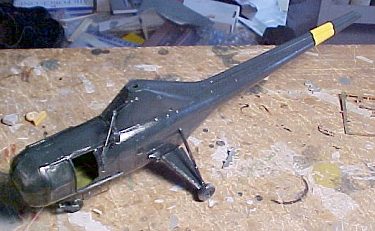 Painting was simple:
mask the windows and shoot Glossy Sea Blue overall, for which I used Gunze-Sanyo
"Midnight Blue." Once it was painted, I put a brushful of white in what was
left of the Midnight Blue in the paint cup, and went over some areas to get some
very light fading - which you cannot see in these photos because it is very
light, but I can assure you it is there.
Painting was simple:
mask the windows and shoot Glossy Sea Blue overall, for which I used Gunze-Sanyo
"Midnight Blue." Once it was painted, I put a brushful of white in what was
left of the Midnight Blue in the paint cup, and went over some areas to get some
very light fading - which you cannot see in these photos because it is very
light, but I can assure you it is there.
The rotor blades were painted with Tamiya Flat yellow for the tips, and Tamiya Semi-Gloss Black for the blades. The rotor hub was painted with SnJ Aluminum paint for hardness to allow future handling.
Decals:
I used the Belcher Bits decals for the "Toko-Ri" Helicopter. One thing I noticed, while looking at the movie again, is that the markings diagram had the "green hat" personal insignia further forward on the fuselage than it was on the real thing.
|
FINAL ASSEMBLY |
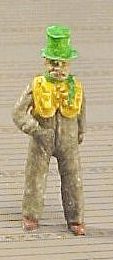 After Futuring the
model, I removed the masking from the windows, painted the tires black, and
assembled the main rotor. I angled the blades down as they were shown in the
movie when the helicopter was parked on deck. I attached the main rotor and
tail rotor.
After Futuring the
model, I removed the masking from the windows, painted the tires black, and
assembled the main rotor. I angled the blades down as they were shown in the
movie when the helicopter was parked on deck. I attached the main rotor and
tail rotor.
The Pilot Figure:
The Belcher Bits kit has a small figure of Chief Forney, a scale 5'1" tall, with hat. I hand-painted the figure as Chief Forney looks in the first scene in the movie. The Mae West is Tamiya Flat Yellow, overpainted with thinned Tamiya "Smoke" to bring out details. The "poopy suit" was painted with Tamiya "RLM Grey," then overpainted with Gunze-Sanyo "RLM Grey" which is a lighter shade, and provides texture. The hat and scarf were painted with Gunze-Sanyo "Bright Green," to which I then added a drop of white and overpainted, to tone it down just a bit.
|
CONCLUSIONS |
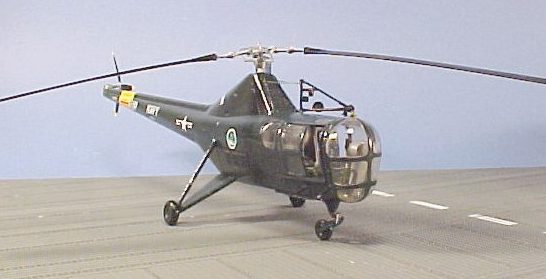 If the HO3S-1 wasn't a
"gotta have" for my collection, I would likely not have proceeded with it after
the destruction of the F-M nose-cap. I deliberately did not get the kit until I
had read some in-box reviews that seemed to indicated Fonderies Miniatures had
finally gotten their act together. I now know why I have yet to see any other
reviews of the kit built-up. Fonderies Miniatures kits are still crap, but if
you reallyreally just gotta have that model, you can accomplish it. I suspect I
spent about three to four times as long as I would have had I been able to buy
this model from an actual kit manufacturer. Why the French limited-run kit
industry can't even get to the level Eduard was at the first day they opened for
business 12 years ago is beyond me.
If the HO3S-1 wasn't a
"gotta have" for my collection, I would likely not have proceeded with it after
the destruction of the F-M nose-cap. I deliberately did not get the kit until I
had read some in-box reviews that seemed to indicated Fonderies Miniatures had
finally gotten their act together. I now know why I have yet to see any other
reviews of the kit built-up. Fonderies Miniatures kits are still crap, but if
you reallyreally just gotta have that model, you can accomplish it. I suspect I
spent about three to four times as long as I would have had I been able to buy
this model from an actual kit manufacturer. Why the French limited-run kit
industry can't even get to the level Eduard was at the first day they opened for
business 12 years ago is beyond me.
Review kit courtesy of my wallet
Tom Cleaver
Copyright ModelingMadness.com. All
rights reserved. No reproduction in part or in whole without express permission.
If you would like your product reviewed fairly and fairly quickly, please
contact the editor or see other details in the Note to
Contributors.